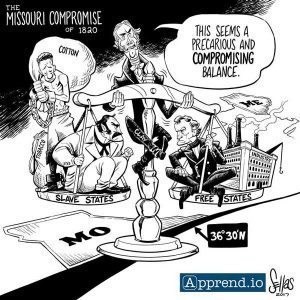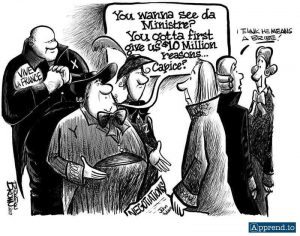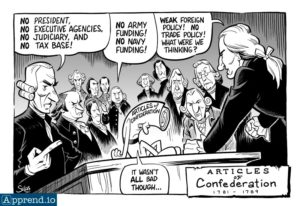Continuity and Change of Slavery Apush
Missouri Compromise admin@apprend.io 2022-02-06T00:02:10+00:00
Missouri Compromise for APUSH®

 About the Author:Christopher Averill has taught AP® US History for 27 years and been actively involved in APUSH® grading for 22 years. Christopher has served as an APUSH® exam reader, table leader, exam leader, and question leader. Christopher was integral in establishing theAP® Teacher Best Practices Workshops at the annual AP® US History reading. He has been endorsed by the College Board as an AP Consultant since 1999 and has conducted numerous AP single-day workshops as well as Teaching and Learning Seminars. Starting in 2010 he began a four year term on the AP® US History Test Development Committee. Additionally, he was a Faculty Consultant editor for the 15 th edition of the Alan Brinkley American History textbook.
About the Author:Christopher Averill has taught AP® US History for 27 years and been actively involved in APUSH® grading for 22 years. Christopher has served as an APUSH® exam reader, table leader, exam leader, and question leader. Christopher was integral in establishing theAP® Teacher Best Practices Workshops at the annual AP® US History reading. He has been endorsed by the College Board as an AP Consultant since 1999 and has conducted numerous AP single-day workshops as well as Teaching and Learning Seminars. Starting in 2010 he began a four year term on the AP® US History Test Development Committee. Additionally, he was a Faculty Consultant editor for the 15 th edition of the Alan Brinkley American History textbook.
The Missouri Compromise of 1820
The Missouri Compromise was an agreement between Northern and Southern states about which western territories could be admitted into the Union as slave states. The Missouri Compromise consisted of three large parts: Missouri entered the Union as a slave state, Maine entered as a free state, and the 36'30" line was established as the dividing line regarding slavery for the remainder of the Louisiana Territory. Any states carved out of land north of this line would be free and any states south of the 36'30"could either choose slavery or no slavery.
This monumental political compromise, crafted by Henry Clay, kept the union together by maintaining the political balance of 12 free states and 12 slave states in the U.S. Senate and settled the question of slavery's expansion into new territories for the next 30 years. The Missouri Compromise was accepted because it: 1) maintained congressional balance in the Senate, 2) allowed for certain new territories to be slave states, and 3) allowed certain new territories to be non-slavery states. Thus, the Compromise appealed in some measure to both the Southerners and Northerners.
Eventually, with the Kansas-Nebraska Act of 1854, the Missouri Compromise was overturned and slavery was decided by popular vote (popular sovereignty);, no matter where a new state was, the people of the state could decide if they wanted to allow slavery or not.
The Tension of Manifest Destiny
With the purchase of the Louisiana Territory from France in 1803, a vast new area of landholdings in excess of 800,000 square miles fell into the lap of the United States. This enormous land acquisition, which came with the principle port of New Orleans, might ensure the success of the American democratic experiment. America would prevent European powers from controlling the Mississippi River and expand America's economic resource base tremendously. The larger question concerned the spread of slavery: Would this land be open to the spread of slavery throughout as southerners hoped or would Congress exert its authority and deny slavery's existence there as many northerners desired?
The question of whether or not Congress would outlaw slavery in new states entering from the Louisiana Purchase would hinge on sectional power; sectional power would be decided by who had more seats in Congress, the North or the South. Though there was a much larger presence of northern Congressmen in the House of Representatives by 1820, the balance between slave and free Senators was tied at 11. Ever since the introduction of Kentucky and Vermont in 1791-1792, the political balance between the sections had been maintained. Both sides understood that if an imbalance towards one section or the other was enacted, then their own economic, cultural and political sentiments would be outvoted by the other. This is why Missouri's request to enter as a slave state in 1820 was so significant.
Questions of Compromise
Missouri's request to join the Union raised a number of questions:
- Would the North allow Missouri to enter as a slave state and if not, what would the South's response be?
- Could Congress legally force an incoming state to change its Constitution as a term of admittance into the Union? Specifically, could Congress dictate to Missouri that it could not enter unless it outlawed further introduction of slavery into its state's borders?
- Even if Congress did have the political power to do this, would preventing slavery in a state violate the 5th Amendment right to property, and thus be unconstitutional?
These are the questions that created such vehement division in America in 1819 and 1820. The issue as Jefferson so aptly described was like a "firebell in the night".
Sectionalism's Lines in the Sand
The Northern Argument
The North believed that since Congress had control over the territories and the admittance of new states that it could determine the slavery solution in the territories. Northern Senators presented the Northwest Ordinance of 1787 as their precedent. This ordinance outlawed the further introduction of slavery into the lands north of the Ohio River. With this precedent in mind, numerous northerners backed a resolution by the Pennsylvanian Congressman, James Tallmadge, which required Missouri to add an amendment to their state constitution that would forbid the further introduction of slavery into the state and that enslaved people presently in Missouri would be freed upon the age of twenty-five. (Synthesis: This amendment was a continuation of gradual emancipation. Gradual emancipation was the practice of northern states gradually emancipating their enslaved people either through state laws or state amendments to their constitutions. Gradual emancipation began in the northern states near the end of the 18th century.)
The North believed that since Congress had control over territories and the admittance of new states that it could dictate on the slavery question in territories.
The Southern Argument
The South was adamant in its rejection of the northern position that Congress could dictate to a state that it could not have slavery. The southern legislators believed that denial of slavery into a state would violate a citizen's 5th amendment right to property (enslaved people at this time were considered property). Additionally, the Northwest Ordinance was not a valid precedence because it was enacted before the Constitution was ratified.
The southern legislators believed that denial of slavery into a state would violate a citizen's 5th amendment right to property.
Economic Context
For the first two decades of the 19th century there was great tension over the proper direction of America's economy. The Hamiltonian vision preached industrialization, while the Jeffersonian vision espoused an agrarian (farming) America.
For the first two decades of the 19th century, there was great tension over the proper direction of America's economy. The Hamiltonian vision preached industrialization, while the Jeffersonian vision espoused an agrarian (farming) America. The northern states had slowly industrialized with the beginnings of textile manufacturing during the American embargo before the War of 1812. The southern states were built upon an agrarian economy because of their reliance on tobacco as a cash crop. Then, due to the introduction of the revolutionary new cotton gin in the 1790's, cotton was now profitable within the southern domain. The upland, interior areas of the South were now opened to cotton production and, as a result, cotton boomed to prominence over the next several decades. Accompanying this crop's growth however came soil butchery, the stripping of the soil of valuable minerals to the point that agricultural production was impossible. This butchery occurred on an unimaginable scale although this was not an immediate problem. Anyone looking into the future would quickly understand that the available lands would most certainly run out within a few short decades. Thus, the southern region looked towards the new virgin lands of the West. However, there were major obstacles in the way. The bulk of the people flooding westward were emigrating from the northern free states and their free labor was in direct opposition to the institution of slavery.
[The Missouri Compromise] a mere preamble, a title page to a great tragic volume. -John Quincy Adams
The Continuity and Change of Compromise
The sectional political balance in the U.S. Senate would be maintained over the next three decades until the Compromise of 1850. Also, the Missouri Compromise allowed the United States to continue its balance between the Hamiltonian vision of industrialization and the Jeffersonian vision of agriculture. However, change was inevitable regarding whether or not Congress could determine the question of slavery's expansion. As John Quincy Adams stated, the Missouri Compromise was "a mere preamble, a title page to a great tragic volume." His quote foreshadowed the complete polarization of the nation over the question of slavery's expansion into the territory as the 19th century progressed. This division began to reveal itself with the reversal of the Missouri Compromise in 1854. Under the Kansas-Nebraska Act, Congress delegated authority for each state, by popular vote, to determine the question of slavery in the territories. Slavery could now effectively move into formerly free territories. The result was violent civil conflict in the Kansas territory (otherwise known as Bleeding Kansas), the destruction of the Whig party, and the fraying of the national union in 1861 with the onset of the Civil War.
Keep Learning!
The Missouri Compromise

Bacon's Rebellion

Mercantilism

The XYZ Affair

Articles of Confederation

Click on a tab to select how you'd like to leave your comment
Source: https://apprend.io/apush/period-4/missouri-compromise/
0 Response to "Continuity and Change of Slavery Apush"
Post a Comment